McCarthyism
From Wikipedia, the free encyclopedia
McCarthyism is the practice of making accusations of
disloyalty, subversion, or treason without proper regard for evidence.
It also means "the practice of making unfair allegations or using unfair
investigative techniques, especially in order to restrict dissent or
political criticism."[1] The term has its origins in the period in the United States known as the Second Red Scare, lasting roughly from 1950 to 1956 and characterized by heightened fears of communist influence on American institutions and espionage by Soviet agents. Originally coined to criticize the anti-communist pursuits of Republican U.S. Senator Joseph McCarthy of Wisconsin,
"McCarthyism" soon took on a broader meaning, describing the excesses
of similar efforts. The term is also now used more generally to describe
reckless, unsubstantiated accusations, as well as demagogic attacks on the character or patriotism of political adversaries.During the McCarthy era, thousands of Americans were accused of being communists or communist sympathizers and became the subject of aggressive investigations and questioning before government or private-industry panels, committees and agencies. The primary targets of such suspicions were government employees, those in the entertainment industry, educators and union activists. Suspicions were often given credence despite inconclusive or questionable evidence, and the level of threat posed by a person's real or supposed leftist associations or beliefs was often greatly exaggerated. Many people suffered loss of employment and/or destruction of their careers; some even suffered imprisonment. Most of these punishments came about through trial verdicts later overturned,[2] laws that would be declared unconstitutional,[3] dismissals for reasons later declared illegal[4] or actionable,[5] or extra-legal procedures that would come into general disrepute.
The most famous examples of McCarthyism include the speeches, investigations, and hearings of Senator McCarthy himself; the Hollywood blacklist, associated with hearings conducted by the House Un-American Activities Committee (HUAC); and the various anti-communist activities of the Federal Bureau of Investigation (FBI) under Director J. Edgar Hoover. McCarthyism was a widespread social and cultural phenomenon that affected all levels of society and was the source of a great deal of debate and conflict in the United States.
Some conservatives regard the term as inappropriate and deprecate what they say are myths created about McCarthy.[6][7][8][9]
Contents
Origins
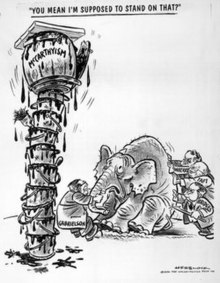
Herbert Block (aka Herblock) coined the term McCarthyism in this Washington Post cartoon of March 29, 1950.
Although the Igor Gouzenko and Elizabeth Bentley affairs had raised the issue of Soviet espionage as far back as 1945, events in 1949 and 1950 sharply increased the sense of threat from Communism in the United States. The Soviet Union tested an atomic bomb in 1949, earlier than many analysts had expected. That same year, Mao Zedong's Communist army gained control of mainland China despite heavy American financial support of the opposing Kuomintang. In 1950, the Korean War began, pitting U.S., U.N., and South Korean forces against Communists from North Korea and China. The following year also saw several significant developments regarding Soviet Cold War espionage activities. In January 1950, Alger Hiss, a high-level State Department official, was convicted of perjury. Hiss was in effect found guilty of espionage; the statute of limitations had run out for that crime, but he was convicted of having perjured himself when he denied that charge in earlier testimony before the House Un-American Activities Committee. In Great Britain, Klaus Fuchs confessed to committing espionage on behalf of the Soviet Union while working on the Manhattan Project at Los Alamos National Laboratory during the War. Julius and Ethel Rosenberg were arrested in 1950 on charges of stealing atomic bomb secrets for the Soviets and were executed in 1953.
There were also more subtle forces encouraging the rise of McCarthyism. It had long been a practice of more conservative politicians to refer to progressive reforms such as child labor laws and women's suffrage as "Communist" or "Red plots."[11] This tendency increased in the 1930s in reaction to the New Deal policies of President Franklin D. Roosevelt. Many conservatives equated the New Deal with socialism or Communism, and saw its policies as evidence that the government had been heavily influenced by Communist policy-makers in the Roosevelt administration.[12] In general, the vaguely defined danger of "Communist influence" was a more common theme in the rhetoric of anti-Communist politicians than was espionage or any other specific activity.
The first recorded use of the term McCarthyism was in a political cartoon by Washington Post editorial cartoonist Herbert Block (aka Herblock), published on March 29, 1950. The cartoon depicted four leading Republicans trying to push an elephant (the traditional symbol of the Republican Party) to stand on a teetering stack of ten tar buckets, the topmost of which was labeled "McCarthyism". Block later wrote that there was "nothing particularly ingenious about the term, which is simply used to represent a national affliction that can hardly be described in any other way. If anyone has a prior claim on it, he's welcome to the word and to the junior senator from Wisconsin along with it. I will also throw in a set of free dishes and a case of soap.”[14]
Institutions
A number of anti-Communist committees, panels, and "loyalty review boards" in federal, state, and local governments, as well as many private agencies carried out investigations for small and large companies concerned about possible Communists in their work force.In Congress, the primary bodies that investigated Communist activities were the House Committee on Un-American Activities, the Senate Internal Security Subcommittee, and the Senate Permanent Subcommittee on Investigations. Between 1949 and 1954, a total of 109 investigations were carried out by these and other committees of Congress.[15]
On the December 2, 1954 the United States Senate voted 65 to 22 to condemn Joseph McCarthy for "conduct that tends to bring the Senate into dishonor and disrepute".
Executive Branch
Loyalty-security reviews
In the federal government, President Harry Truman's Executive Order 9835 initiated a program of loyalty reviews for federal employees in 1947. It called for dismissal if there were "reasonable grounds ... for belief that the person involved is disloyal to the Government of the United States."[16] Truman, a Democrat, was probably reacting in part to the Republican sweep in the 1946 Congressional election and felt a need to counter growing criticism from conservatives and anti-communists.[17]When President Dwight Eisenhower took office in 1953, he strengthened and extended Truman's loyalty review program, while decreasing the avenues of appeal available to dismissed employees. Hiram Bingham, Chairman of the Civil Service Commission Loyalty Review Board, referred to the new rules he was obliged to enforce as "just not the American way of doing things."[18] The following year, J. Robert Oppenheimer, scientific director of the Manhattan Project that built the first atomic bomb, then working as a consultant to the Atomic Energy Commission, was stripped of his security clearance after a four-week hearing. Oppenheimer had received a top-secret clearance in 1947, but was denied clearance in the harsher climate of 1954.
Similar loyalty reviews were established in many state and local government offices and some private industries across the nation. In 1958 it was estimated that roughly one out of every five employees in the United States was required to pass some sort of loyalty review.[19] Once a person lost a job due to an unfavorable loyalty review, it could be very difficult to find other employment. "A man is ruined everywhere and forever," in the words of the chairman of President Truman's Loyalty Review Board. "No responsible employer would be likely to take a chance in giving him a job."[20]
The Department of Justice started keeping a list of organizations that it deemed subversive beginning in 1942. This list was first made public in 1948, when it included 78 items. At its longest, it comprised 154 organizations, 110 of them identified as Communist. In the context of a loyalty review, membership in a listed organization was meant to raise a question, but not to be considered proof of disloyalty. One of the most common causes of suspicion was membership in the Washington Bookshop Association, a left-leaning organization that offered lectures on literature, classical music concerts and discounts on books.[21]
J. Edgar Hoover and the FBI
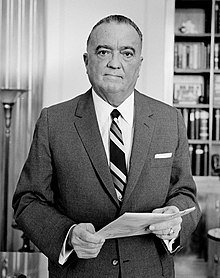
J. Edgar Hoover in 1961
Hoover designed President Truman's loyalty-security program, and its background investigations of employees were carried out by FBI agents. This was a major assignment that led to the number of agents in the Bureau being increased from 3,559 in 1946 to 7,029 in 1952. Hoover's extreme sense of the Communist threat and the politically conservative standards of evidence applied by his bureau resulted in thousands of government workers losing their jobs. Due to Hoover's insistence upon keeping the identity of his informers secret, most subjects of loyalty-security reviews were not allowed to cross-examine or know the identities of those who accused them. In many cases they were not even told what they were accused of.[23]
Hoover's influence extended beyond federal government employees and beyond the loyalty-security programs. The records of loyalty review hearings and investigations were supposed to be confidential, but Hoover routinely gave evidence from them to congressional committees such as HUAC.[24]
From 1951 to 1955, the FBI operated a secret "Responsibilities Program" that distributed anonymous documents with evidence from FBI files of Communist affiliations on the part of teachers, lawyers, and others. Many people accused in these "blind memoranda" were fired without any further process.[25]
The FBI engaged in a number of illegal practices in its pursuit of information on Communists, including burglaries, opening mail and illegal wiretaps.[26] The members of the left-wing National Lawyers Guild were among the few attorneys who were willing to defend clients in communist-related cases, and this made the NLG a particular target of Hoover's. The office of this organization was burgled by the FBI at least fourteen times between 1947 and 1951.[27]
Among other purposes, the FBI used its illegally obtained information to alert prosecuting attorneys about the planned legal strategies of NLG defense lawyers.
The FBI also used illegal undercover operations to disrupt Communist and other dissident political groups. In 1956, Hoover was becoming increasingly frustrated by Supreme Court decisions that limited the Justice Department's ability to prosecute Communists. At this time he formalized a covert "dirty tricks" program under the name COINTELPRO.[26] COINTELPRO actions included planting forged documents to create the suspicion that a key person was an FBI informer, spreading rumors through anonymous letters, leaking information to the press, calling for IRS audits, and the like. The COINTELPRO program remained in operation until 1971.
House Committee on Un-American Activities
Main article: House Un-American Activities Committee
The House Committee on Un-American Activities - commonly referred to
as the House Un-American Activities Committee (HUAC) - was the most
prominent and active government committee involved in anti-Communist
investigations. Formed in 1938 and known as the Dies Committee for Rep. Martin Dies,
who chaired it until 1944, HUAC investigated a variety of "activities,"
including those of German-American Nazis during World War II. The
Committee soon focused on Communism, beginning with an investigation
into Communists in the Federal Theatre Project in 1938. A significant step for HUAC was its investigation of the charges of espionage brought against Alger Hiss
in 1948. This investigation ultimately resulted in Hiss's trial and
conviction for perjury, and convinced many of the usefulness of
congressional committees for uncovering Communist subversion.HUAC achieved its greatest fame and notoriety with its investigation into the Hollywood film industry. In October 1947, the Committee began to subpoena screenwriters, directors, and other movie industry professionals to testify about their known or suspected membership in the Communist Party, association with its members, or support of its beliefs. It was at these testimonies that what became known as the "$64 question" was asked: "Are you now or have you ever been a member of the Communist Party of the United States?" Among the first film industry witnesses subpoenaed by the Committee were ten who decided not to cooperate. These men, who became known as the "Hollywood Ten", cited the First Amendment's guarantee of free speech and free assembly, which they believed legally protected them from being required to answer the Committee's questions. This tactic failed, and the ten were sentenced to prison for contempt of Congress. Two of the ten were sentenced to six months, the rest to a year.
In the future, witnesses (in the entertainment industries and otherwise) who were determined not to cooperate with the Committee would claim their Fifth Amendment protection against self-incrimination. While this usually protected them from a contempt of Congress citation, it was considered grounds for dismissal by many government and private industry employers. The legal requirements for Fifth Amendment protection were such that a person could not testify about his own association with the Communist Party and then refuse to "name names" of colleagues with Communist affiliations.[28] Thus many faced a choice between "crawl[ing] through the mud to be an informer," as actor Larry Parks put it, or becoming known as a "Fifth Amendment Communist"—an epithet often used by Senator McCarthy.[29]
Senate committees
In the Senate, the primary committee for investigating Communists was the Senate Internal Security Subcommittee (SISS), formed in 1950 and charged with ensuring the enforcement of laws relating to "espionage, sabotage, and the protection of the internal security of the United States." The SISS was headed by Democrat Pat McCarran and gained a reputation for careful and extensive investigations. This committee spent a year investigating Owen Lattimore and other members of the Institute of Pacific Relations. As had been done numerous times before, the collection of scholars and diplomats associated with Lattimore (the so-called China Hands) were accused of "losing China," and while some evidence of pro-communist attitudes was found, there was nothing to support McCarran's accusation that Lattimore was "a conscious and articulate instrument of the Soviet conspiracy". Lattimore was charged with perjuring himself before the SISS in 1952. After many of the charges were rejected by a Federal Judge and one of the witnesses confessed to perjury, the case was dropped in 1955.[30]Joseph McCarthy himself headed the Senate Permanent Subcommittee on Investigations in 1953 and 1954, and during that time used it for a number of his Communist-hunting investigations. McCarthy first examined allegations of Communist influence in the Voice of America, and then turned to the overseas library program of the State Department. Card catalogs of these libraries were searched for works by authors McCarthy deemed inappropriate. McCarthy then recited the list of supposedly pro-communist authors before his subcommittee and the press. Yielding to the pressure, the State Department ordered its overseas librarians to remove from their shelves "material by any controversial persons, Communists, fellow travelers, etc." Some libraries actually burned the newly forbidden books.[31]
McCarthy's committee then began an investigation into the United States Army. This began at the Army Signal Corps laboratory at Fort Monmouth. McCarthy garnered some headlines with stories of a dangerous spy ring among the Army researchers, but ultimately nothing came of this investigation.[32] McCarthy next turned his attention to the case of a U.S. Army dentist who had been promoted to the rank of major despite having refused to answer questions on an Army loyalty review form. McCarthy's handling of this investigation, including a series of insults directed at a brigadier general, led to the Army-McCarthy hearings, with the Army and McCarthy trading charges and counter-charges for 36 days before a nationwide television audience. While the official outcome of the hearings was inconclusive, this exposure of McCarthy to the American public resulted in a sharp decline in his popularity.[33] In less than a year, McCarthy was censured by the Senate and his position as a prominent force in anti-communism was essentially ended.[34]
Blacklists
At this time, private loyalty-review boards and anti-communist investigators began to appear to fill a growing demand among certain industries to certify that their employees were above reproach. Companies that were concerned about the sensitivity of their business, or who, like the entertainment industry, felt particularly vulnerable to public opinion made use of these private services. For a fee, these teams would investigate employees and question them about their politics and affiliations. At such hearings, the subject would usually not have a right to the presence of an attorney, and as with HUAC, the interviewee might be asked to defend himself against accusations without being allowed to cross-examine the accuser. These agencies would keep cross-referenced lists of leftist organizations, publications, rallies, charities and the like, as well as lists of individuals who were known or suspected communists. Books such as Red Channels and newsletters such as Counterattack and Confidential Information were published to keep track of communist and leftist organizations and individuals.[35] Insofar as the various blacklists of McCarthyism were actual physical lists, they were created and maintained by these private organizations.
Laws and arrests
Efforts to protect the United States from the perceived threat of Communist subversion were particularly enabled by several federal laws. The Alien Registration Act or Smith Act of 1940 made it a criminal offense for anyone to "knowingly or willfully advocate, abet, advise or teach the [...] desirability or propriety of overthrowing the Government of the United States or of any State by force or violence, or for anyone to organize any association which teaches, advises or encourages such an overthrow, or for anyone to become a member of or to affiliate with any such association". Hundreds of Communists and others were prosecuted under this law between 1941 and 1957. Eleven leaders of the Communist Party were convicted under the Smith Act in 1949 in the Foley Square trial. Ten defendants were given sentences of five years and the eleventh was sentenced to three years. The defense attorneys were cited for contempt of court and given prison sentences.[36] In 1951, twenty-three other leaders of the party were indicted, including Elizabeth Gurley Flynn, a founding member of the American Civil Liberties Union. Many were convicted on the basis of testimony that was later admitted to be false.[37] By 1957, 140 leaders and members of the Communist Party had been charged under the law, of whom 93 were convicted.[38]The McCarran Internal Security Act, which became law in 1950, has been described by scholar Ellen Schrecker as "the McCarthy era's only important piece of legislation"[39] (the Smith Act technically predated McCarthyism). However, the McCarran Act had no real effect beyond legal harassment. It required the registration of Communist organizations with the U.S. Attorney General and established the Subversive Activities Control Board to investigate possible Communist-action and Communist-front organizations so they could be required to register. Due to numerous hearings, delays and appeals, the act was never enforced, even with regard to the Communist Party of the United States itself, and the major provisions of the act were found to be unconstitutional in 1965 and 1967.[40] In 1952, the Immigration and Nationality, or McCarran-Walter, Act was passed. This law allowed the government to deport immigrants or naturalized citizens engaged in subversive activities and also to bar suspected subversives from entering the country.
The Communist Control Act of 1954 was passed with overwhelming support in both houses of Congress after very little debate. Jointly drafted by Republican John Marshall Butler and Democrat Hubert Humphrey, the law was an extension of the Internal Security Act of 1950, and sought to outlaw the Communist Party by declaring that the party, as well as "Communist-Infiltrated Organizations" were "not entitled to any of the rights, privileges, and immunities attendant upon legal bodies". The Communist Control Act never had any significant effect, and was perhaps most notable for the odd mix of liberals and conservatives among its supporters. It was successfully applied only twice: in 1954 it was used to prevent Communist Party members from appearing on the New Jersey state ballot, and in 1960 it was cited to deny the CPUSA recognition as an employer under New York State's unemployment compensation system. The New York Post called the act "a monstrosity", "a wretched repudiation of democratic principles," while The Nation accused Democratic liberals of a "neurotic, election-year anxiety to escape the charge of being 'soft on Communism' even at the expense of sacrificing constitutional rights."[41]
Popular support
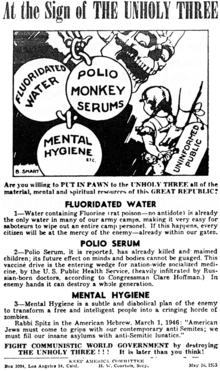
Flier issued in May 1955 by the Keep America Out of War Committee urging readers to "fight communistic world government" by opposing public health programs.
Although far-right radicals were the bedrock of support for McCarthyism, they were not alone. A broad "coalition of the aggrieved" found McCarthyism attractive, or at least politically useful. Common themes uniting the coalition were opposition to internationalism, particularly the United Nations; opposition to social welfare provisions, particularly the various programs established by the New Deal; and opposition to efforts to reduce inequalities in the social structure of the United States.[43]
One focus of popular McCarthyism concerned the provision of public health services, particularly vaccination, mental health care services and fluoridation, all of which were deemed by some to be communist plots to poison or brainwash the American people. At times, the anti-internationalist aspect of McCarthyist literature took on an anti-Jewish tone. (See flier at right: Rabbi Spitz in the American Hebrew, March 1, 1946: "American Jews must come to grips with our contemporary anti-Semites; we must fill our insane asylums with anti-Semitic lunatics.") Such viewpoints led to major collisions between McCarthyite radicals and supporters of public health programs, most notably in the case of the Alaska Mental Health Bill controversy of 1956.[44]
William F. Buckley, Jr., the founder of the influential conservative political magazine National Review, wrote a defense of McCarthy, McCarthy and his Enemies, in which he asserted that "McCarthyism ... is a movement around which men of good will and stern morality can close ranks."[45]
In addition, as Richard Rovere points out, many ordinary Americans became convinced that there must be "no smoke without fire" and lent their support to McCarthyism. In January 1954, a Gallup poll found that 50% of the American public supported McCarthy, while 29% had an unfavorable opinion of the senator. Earl Warren, the Chief Justice of the United States, commented that if the United States Bill of Rights had been put to a vote it probably would have been defeated.[43]
Portrayals of Communists
Those who sought to justify McCarthyism did so largely through their characterization of Communism, and American Communists in particular. Proponents of McCarthyism claimed that the CPUSA was so completely under Moscow's control that any American Communist is a puppet of the Soviet and Russian intelligence services. This view is supported by recent documentation from the archives of the KGB[46] as well as post-war decodes of wartime Soviet radio traffic from the Venona Project,[47] showing the CPUSA as having been completely controlled from Moscow. J. Edgar Hoover commented in a 1950 speech, "Communist members, body and soul, are the property of the Party." This attitude was not confined to arch-conservatives. In 1940, the American Civil Liberties Union ejected founding member Elizabeth Gurley Flynn, saying that her membership in the Communist Party was enough to disqualify her as a civil libertarian. In the government's prosecutions of Communist Party members under the Smith Act (see above), the prosecution case was based not on specific actions or statements by the defendants, but on the premise that a commitment to violent overthrow of the government was inherent in the doctrines of Marxism-Leninism. Passages of the CPUSA's constitution that specifically rejected revolutionary violence were dismissed as deliberate deception.[48]In addition, it was often claimed that the Party did not allow any member to resign, so a person who had been a member for a short time decades previously could be considered as suspect as a current member. Many of the hearings and trials of McCarthyism featured testimony by former Communist Party members such as Elizabeth Bentley, Louis Budenz, and Whittaker Chambers, speaking as expert witnesses.[49][50]
Victims of McCarthyism
It is difficult to estimate the number of victims of McCarthyism. The number imprisoned is in the hundreds, and some ten or twelve thousand lost their jobs.[51] In many cases simply being subpoenaed by HUAC or one of the other committees was sufficient cause to be fired.[52] Many of those who were imprisoned, lost their jobs or were questioned by committees did in fact have a past or present connection of some kind with the Communist Party. But for the vast majority, both the potential for them to do harm to the nation and the nature of their communist affiliation were tenuous.[53] Suspected homosexuality was also a common cause for being targeted by McCarthyism. The hunt for "sexual perverts", who were presumed to be subversive by nature, resulted in thousands being harassed and denied employment.[54] Many have termed this aspect of McCarthyism “The Lavender Scare” [55].Homosexuality was classified as a psychiatric disorder in the 1950s [56]. However, in the context of the highly politicised Cold War environment, homosexuality became framed as a dangerous, contagious social disease that posed a potential threat to state security [57]. As the family was believed to be the cornerstone of American strength and integrity [58], the stigmatisation of homosexuals as “sexual perverts” meant that they were both unable to function within a family unit and presented the potential to poison the social body [59]. This era also witnessed the establishment of widely spread FBI surveillance intended to identify homosexual government employees [60].
The McCarthy hearings and according “sexual pervert” investigations can be seen to have been driven by a desire to identify individuals whose ability to function as loyal citizens had been compromised [61]. Joseph McCarthy began his campaign by drawing upon the ways in which he embodied traditional American values in order to become the self-appointed vanguard of social morality [62].Paradoxically, accusations of alleged homosexual behaviour marked the end of McCarthy’s political career [63].
A few of the more notable people who were blacklisted or suffered some other persecution during McCarthyism are listed here:
- Nelson Algren, writer[65]
- Elmer Bernstein, composer and conductor[66]
- Leonard Bernstein, conductor, pianist, composer[67]
- David Bohm, physicist and philosopher[68]
- Bertolt Brecht, poet, playwright, screenwriter
- Luis Buñuel, film director, producer[69]
- Charlie Chaplin, actor and director[70]
- Aaron Copland, composer[71]
- Bartley Crum, attorney[72]
- Howard Da Silva, actor[73]
- Jules Dassin, director[74]
- Dolores del Río, actress[75]
- W.E.B. Du Bois, civil rights activist and author[76]
- George A. Eddy, pre-Keynsian Harvard economist, US Treasury monetary policy specialist [77]
- Albert Einstein, Nobel Prize-winning physicist, philosopher, mathematician, activist[78]
- Hanns Eisler, composer[79]
- Howard Fast, writer[80]
- Lion Feuchtwanger, novelist and playwright[81]
- Carl Foreman, writer of High Noon
- John Garfield, actor[71]
- Jack Gilford, actor[73]
- Allen Ginsberg, beat-poet
- Ruth Gordon, actress[73]
- Lee Grant, actress[82]
- Dashiell Hammett, author[71]
- Elizabeth Hawes, clothing designer, author, equal rights activist[83]
- Lillian Hellman, playwright[71]
- Lena Horne, singer[73]
- Langston Hughes, writer[71]
- Marsha Hunt, actress
- Sam Jaffe, actor[71]
- Theodore Kaghan, diplomat[84]
- Garson Kanin, writer and director[71]
- Danny Kaye, comedian, singer[85][broken citation]
- Benjamin Keen, historian[86]
- Otto Klemperer, conductor and composer[87]
- Gypsy Rose Lee, actress and stripper[71]
- Cornelius Lanczos, mathematician and physicist[88]
- Arthur Laurents, playwright[73]
- Philip Loeb, actor[89]
- Joseph Losey, director[71]
- Heinrich Mann, novelist[90]
- Klaus Mann, writer[90]
- Thomas Mann, Nobel Prize winning novelist and essayist[90]
- Burgess Meredith, actor[71]
- Arthur Miller, playwright and essayist[71]
- Dimitri Mitropoulos, conductor, pianist, composer[91]
- Zero Mostel, actor[71]
- Joseph Needham, biochemist, sinologist, historian of science
- J. Robert Oppenheimer, physicist, scientific director of the Manhattan Project[92]
- Dorothy Parker, writer[71]
- Linus Pauling, chemist, winner of two Nobel prizes[93]
- Samuel Reber, diplomat[94]
- Martin Ritt, actor and director[95]
- Paul Robeson, actor, athlete, singer, writer, political activist[96]
- Edward G. Robinson, actor[71]
- Waldo Salt, screenwriter[97]
- Jean Seberg, actress[98]
- Pete Seeger, folk singer[71]
- Artie Shaw, jazz musician[71]
- Irwin Shaw, writer[73]
- William L. Shirer, journalist[99]
- Lionel Stander, actor[100]
- Dirk Jan Struik, mathematician, historian of maths[101]
- Paul Sweezy, economist and founder-editor of Monthly Review[102]
- Charles W. Thayer, diplomat[103]
- Tsien Hsue-shen, physicist[104]
- Orson Welles, actor, author, film director[citation needed]
- Gene Weltfish, anthropologist. Fired from her position at Columbia in 1953 and unable to secure a new position for the next 9 years.[105]
Critical reactions
The nation was by no means united behind the policies and activities that have come to be identified as McCarthyism. There were many critics of various aspects of McCarthyism, including many figures not generally noted for their liberalism.For example, in his overridden veto of the McCarran Internal Security Act of 1950, President Truman wrote, "In a free country, we punish men for the crimes they commit, but never for the opinions they have."[107] Truman also unsuccessfully vetoed the Taft-Hartley Act, which among other provisions denied trade unions National Labor Relations Board protection unless union leaders signed affidavits swearing they were not and had never been Communists. In 1953, after he left office, Truman criticized the current Eisenhower administration:
It is now evident that the present Administration has fully embraced, for political advantage, McCarthyism. I am not referring to the Senator from Wisconsin. He is only important in that his name has taken on the dictionary meaning of the word. It is the corruption of truth, the abandonment of the due process law. It is the use of the big lie and the unfounded accusation against any citizen in the name of Americanism or security. It is the rise to power of the demagogue who lives on untruth; it is the spreading of fear and the destruction of faith in every level of society.[108]On June 1, 1950, Senator Margaret Chase Smith, a Maine Republican, delivered a speech to the Senate she called a "Declaration of Conscience". In a clear attack upon McCarthyism, she called for an end to "character assassinations" and named "some of the basic principles of Americanism: The right to criticize; The right to hold unpopular beliefs; The right to protest; The right of independent thought". She said "freedom of speech is not what it used to be in America", and decried "cancerous tentacles of 'know nothing, suspect everything' attitudes".[109] Six other Republican Senators—Wayne Morse, Irving M. Ives, Charles W. Tobey, Edward John Thye, George Aiken, and Robert C. Hendrickson—joined Smith in condemning the tactics of McCarthyism.

Joseph N. Welch (left) and Senator McCarthy, June 9, 1954
In 1952, the Supreme Court upheld a lower court decision in Adler v. Board of Education of New York, thus approving a law that allowed state loyalty review boards to fire teachers deemed "subversive". In his dissenting opinion, Justice William O. Douglas wrote: "The present law proceeds on a principle repugnant to our society — guilt by association.[...] What happens under this law is typical of what happens in a police state. Teachers are under constant surveillance; their pasts are combed for signs of disloyalty; their utterances are watched for clues to dangerous thoughts."[111]
We must not confuse dissent with disloyalty. We must remember always that accusation is not proof and that conviction depends upon evidence and due process of law. We will not walk in fear, one of another. We will not be driven by fear into an age of unreason, if we dig deep in our history and our doctrine, and remember that we are not descended from fearful men.[29]This broadcast has been cited as a key episode in bringing about the end of McCarthyism.[112]
In April 1954, Senator McCarthy was also under attack in the Army–McCarthy hearings. These hearings were televised live on the new American Broadcasting Company network, allowing the public to view first-hand McCarthy's interrogation of individuals and his controversial tactics. In one exchange, McCarthy reminded the attorney for the Army, Joseph Welch, that he had an employee in his law firm who had belonged to an organization that had been accused of Communist sympathies. In an exchange that reflected the increasingly negative public opinion of McCarthy, Welch famously rebuked the senator: "Have you no sense of decency, sir? At long last, have you left no sense of decency?"[113]
Decline
In the mid- and late 1950s, the attitudes and institutions of McCarthyism slowly weakened. Changing public sentiments heavily contributed to the decline of McCarthyism. Its decline may also be charted through a series of court decisions.A key figure in the end of the blacklisting of McCarthyism was John Henry Faulk. Host of an afternoon comedy radio show, Faulk was a leftist active in his union, the American Federation of Television and Radio Artists. He was scrutinized by AWARE, Inc., one of the private firms that examined individuals for signs of communist "disloyalty". Marked by AWARE as unfit, he was fired by CBS Radio. Almost uniquely among the many victims of blacklisting, Faulk decided to sue AWARE in 1957 and finally won the case in 1962.[114] With this court decision, the private blacklisters and those who used them were put on notice that they were legally liable for the professional and financial damage they caused. Although some informal blacklisting continued, the private "loyalty checking" agencies were soon a thing of the past.[115] Even before the Faulk verdict, many in Hollywood had decided it was time to break the blacklist. In 1960, Dalton Trumbo, one of the best known members of the Hollywood Ten, was publicly credited with writing the films Exodus and Spartacus.
Much of the undoing of McCarthyism came at the hands of the Supreme Court. As Richard Rovere wrote in his biography of Joseph McCarthy, "[T]he United States Supreme Court took judicial notice of the rents McCarthy was making in the fabric of liberty and thereupon wrote a series of decisions that have made the fabric stronger than before."[116] Two Eisenhower appointees to the court—Earl Warren (who was made Chief Justice) and William J. Brennan, Jr.—proved to be more liberal than Eisenhower had anticipated, and he would later refer to the appointment of Warren as his "biggest mistake".[117]
In 1956, the Supreme Court heard the case of Slochower v. Board of Education. Harry Slochower was a professor at Brooklyn College who had been fired by New York City for invoking the Fifth Amendment when McCarthy's committee questioned him about his past membership in the Communist Party. The court prohibited such actions, ruling "...we must condemn the practice of imputing a sinister meaning to the exercise of a person's constitutional right under the Fifth Amendment.[...] The privilege against self-incrimination would be reduced to a hollow mockery if its exercise could be taken as equivalent either to a confession of guilt or a conclusive presumption of perjury."[118]
Another key decision was in the 1957 case Yates v. United States, in which the convictions of fourteen Communists were reversed. In Justice Black's opinion, he wrote of the original "Smith Act" trials: "The testimony of witnesses is comparatively insignificant. Guilt or innocence may turn on what Marx or Engels or someone else wrote or advocated as much as a hundred years or more ago.[...] When the propriety of obnoxious or unfamiliar view about government is in reality made the crucial issue, [...] prejudice makes conviction inevitable except in the rarest circumstances."[119]
Also in 1957, the Supreme Court ruled on the case of Watkins v. United States, curtailing the power of HUAC to punish uncooperative witnesses by finding them in contempt of Congress. Justice Warren wrote in the decision: "The mere summoning of a witness and compelling him to testify, against his will, about his beliefs, expressions or associations is a measure of governmental interference. And when those forced revelations concern matters that are unorthodox, unpopular, or even hateful to the general public, the reaction in the life of the witness may be disastrous."[120]
In its 1958 decision in Kent v. Dulles, the Supreme Court halted the State Department from using the authority of its own regulations to refuse or revoke passports based on an applicant's communist beliefs or associations.[121]
Repercussions
The political divisions McCarthyism created in the United States continue to make themselves manifest, and the politics and history of anti-Communism in the United States are still contentious. Portions of the massive security apparatus established during the McCarthy era still exist. Loyalty oaths are still required by the California Constitution for all officials and employees of the government of California (which is highly problematic for Quakers and Jehovah's Witnesses whose beliefs preclude them from pledging absolute loyalty to the state),[122] and at the federal level, a few portions of the McCarran Internal Security Act are still in effect. A number of observers have compared the oppression of liberals and leftists during the McCarthy period to recent actions against suspected terrorists, most of them Muslims. In The Age of Anxiety: McCarthyism to Terrorism, author Haynes Johnson compares the "abuses suffered by aliens thrown into high security U.S. prisons in the wake of 9/11" to the excesses of the McCarthy era.[123] Similarly, David D. Cole has written that the Patriot Act "in effect resurrects the philosophy of McCarthyism, simply substituting 'terrorist' for 'communist.'"[124]From the opposite pole, conservative pundit Ann Coulter devotes much of her book Treason to drawing parallels between past opposition to McCarthy and McCarthyism and the policies and beliefs of modern-day liberals, arguing that the former hindered the anti-Communist cause and the latter hinder the War on Terrorism.[125] Other authors who have drawn on a comparison between current anti-terrorism policies and McCarthyism include Geoffrey R. Stone,[126] Ted Morgan,[127] and Jonah Goldberg.[128]
McCarthyism also attracts controversy purely as a historical issue. Through declassified documents from Soviet archives and Venona project decryptions of coded Soviet messages, it has become known that the Soviet Union engaged in substantial espionage activities in the United States during the 1940s. It is also known that the Communist Party USA was substantially funded and its policies controlled by the Soviet Union, and there are accusations that CPUSA members were often recruited as spies.[129] In the view of some contemporary commentators, these revelations stand as at least a partial vindication of McCarthyism.[130] Some feel that there was a genuinely dangerous subversive element in the United States, and that this danger justified extreme measures.[128] Others, while acknowledging that there were inexcusable excesses during McCarthyism, argue that some contemporary historians of McCarthyism underplay the depth of Soviet espionage in America[131] or the undemocratic nature of the CPUSA,[132] the latter concern being shared by some Trotskyites who felt that they, and anti-Stalin socialists in general, were persecuted by the CPUSA.[133] The opposing view holds that, recent revelations notwithstanding, by the time McCarthyism began in the late 1940s, the CPUSA was an ineffectual fringe group, and the damage done to U.S. interests by Soviet spies after World War II was minimal.[134] Historian Ellen Schrecker has written, "in this country, McCarthyism did more damage to the constitution than the American Communist Party ever did."[135]
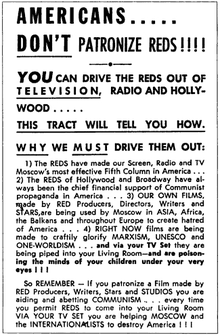
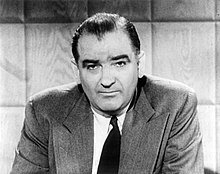


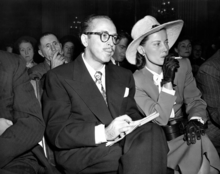
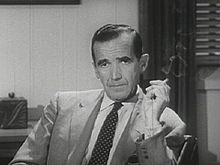
No comments:
Post a Comment
Please leave a comment-- or suggestions, particularly of topics and places you'd like to see covered